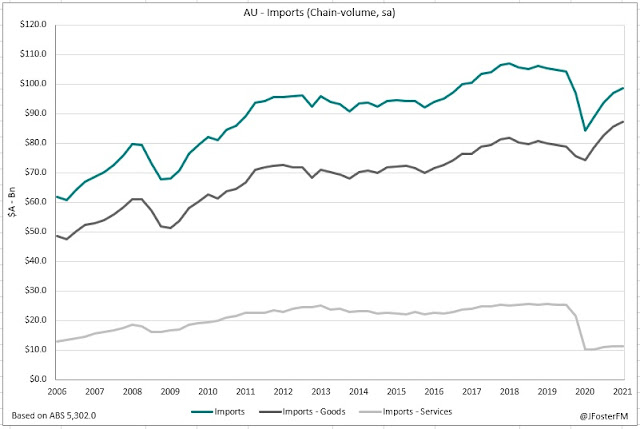Australia's current account surplus has continued to surge reaching a new record high in the June quarter. Elevated commodity prices are driving national income higher, though net exports will subtract heavily from GDP in Q2 due to disruptions affecting resource shipments to offshore markets.
- Australia's current account was in surplus by $20.5bn in Q2, lifting from $18.9bn in the previous quarter (revised from $18.3bn) but lower than the market forecast for $21.4bn.
- The trade surplus widened by $3.7bn over the quarter to a record high at $28.9bn.
- The income deficit expanded by $1.1bn to $7.4bn.
- ABS reported that net exports will take away 1.0ppt from quarterly GDP in Q2.
Balance of Payments — Q2 | The details
Australia extended its run of quarterly current account surpluses out to 9 in the June quarter. The latest showing was the nation's largest on record, going through $20bn to be equivalent to a sizeable 3.9% of GDP.
Driving the rise in the current account surplus was a widening in the trade balance, from $25.4bn to $28.9bn. This reflected surging commodity prices, with export earnings seeing another strong uplift rising by 5.9% in the quarter (18.4%Y/Y). Import spending increased 3.7% (14.4%Y/Y) on robust domestic demand. The wider trade balance was moderated by an increase in the income deficit for the quarter, from $6.2bn to $7.4bn, on higher returns to foreign investors.
Trade volumes pointed to a sizeable negative contribution from net exports to quarterly GDP of -1.0ppt. Exports contracted by 3.2% in the quarter to be 2.6% lower through the year and remained substantially (-13.9%) below pre-pandemic levels. That predominantly reflects weakness in services exports (-45.6% vs pre-pandemic) due to the closure of the international border, though goods exports are also lower over the period (-5.0%).
In Q2, the weakness was in non-rural goods (-2.8%) and non-monetary gold (-25.7%q/q). Across these two categories, resource exports were substantially weaker in the quarter (-5.9%) and through the year (-6.4%), to be at their lowest level in 3½ years. Adverse weather and maintenance activity were key factors in this weakness.
Imports lifted for a 4th consecutive quarter rising by 1.5% in Q2 (16.8%Y/Y). A strong economic recovery in Australia has drawn in imports, though they are still 5.4% down on pre-pandemic levels. Beneath the surface, we see one of the main themes to emerge from COVID — that being the rotation in spending away from services to goods. Services imports (-55.2% vs pre-pandemic) have been crunched by the overseas travel ban, but goods imports have surged to be up by 10.5% since the end of 2019.
Intermediate goods led in Q2 with a 3.1% lift, while capital goods increased to a 2.2% gain from 0.9% in the previous quarter. Consumption goods were broadly flat in the quarter (-0.1%). All goods-related categories are elevated compared to pre-pandemic levels, reflective of the robust recovery in domestic demand seen in Australia.
Balance of Payments — Q2 | Insights
Contrasting details ahead of tomorrow's Q2 GDP data. While net exports are a significant weight on activity in the quarter, mainly due to disruptions in the resources sector, nominal outcomes were strong. The terms of trade look to be up by 7% in the quarter, boosting company profits, wages and government revenues.







